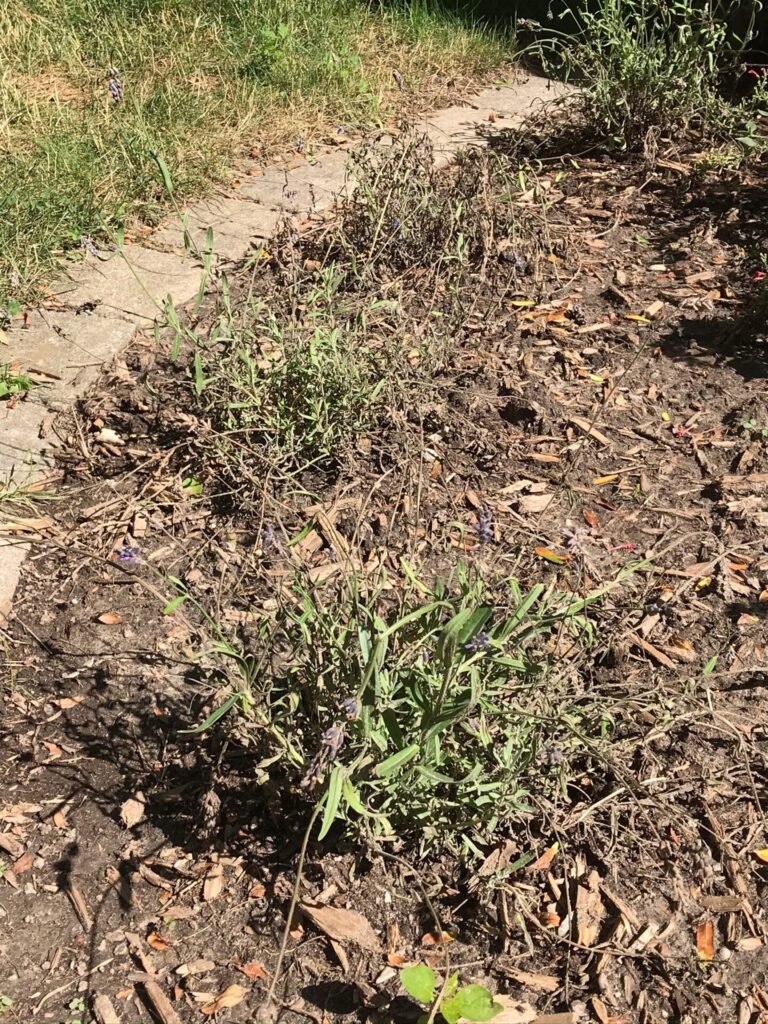
I hired a gardener to design an area of my garden and one of the plants that were implanted was and English Lavender Super Blue (Lavendula angustifolia). There were 20 planted in rows in the border on either side of the garden. Despite careful watering (not over watering), one by one they started to shrivel and dry up and appear to have no green foliage. Of the 20, 10 have died and 4 are dying. Would you be able to identify whether they had some kind of disease that caused this? Thanks very much.
What a shame. It sounds as if you had a beautiful design.
It is hard to diagnose what is happening from your photo but let’s review some general possibilities starting with some cultural practices:
It seems from your question, that the garden was recently planted? Though an ideal time to plant lavender is the spring as this gives the plant time to adjust before having to deal with summer heat, this year, planting everywhere was late due to the locked down pandemic economy ..lots of gardens are suffering from less than ideal planting weather followed by the quick onset of summer record breaking heat .
Even in normal years, plants do wilt after planting as they adjust to their new environment but this is temporary if best care practices are followed so let’s review some of those basics too . Lavender is not only gorgeous but loves to be neglected once it is established and prefers poor soil to rich soil ( in their hot native homes , they live in stony or sandy soils..think southern France!) . It loves sun and must have 6 hours or more each day .
Your question suggests that you are attune to the problem of overwatering so we will assume that that is not the problem but let’s just review that lavender is drought tolerant and it is tricky to get the balance between over watering and underwatering , right .It must dry out between watering because consistently moist soil leads to root rot and creates conditions for fungal disease( as does watering from above instead of at the roots ) . Ironically, browning and wilting occur as a sign of overwatering.
All that said, you state that the problem spread one by one , suggesting that cultural practices ( when all the plants would die simultaneously) are not the issue. There are lots of conditions and pests that can affect lavender. The Ontario Ministry of Agriculture , Food and Rural Affairs names some at http://www.omafra.gov.on.ca/CropOp/en/herbs/lavender.html which lists phytophthora root rot ( not a problem in dry soil but in wet soil, attacks the roots ) , Fusarium fungus , Shab disease, vascular wilt, and some insects . These problems can be spread in various and often surprisingly simple ways, like people walking , brushing up against the infected or infested plant and then carrying it to the next plant .If you google “lavender diseases and pests” , the photos may help you identify which of these , is your culprit .
Since your photo seems to show dead patches at the base, you might find it helpful to look at Washington State University’s paper at https://s3.wp.wsu.edu/uploads/sites/410/2017/03/Phytophthora-diseases-of-lavender.pdf
Would the best practical way of dealing with this be to consult your gardener to see if there is a guarantee ? And at the very least , remove the affected plants immediately before whatever the problem is , continues to spread? If you decide that your problem is a disease or infestation , consider replacement plants of another species or at least not planted in the same spot .
I hope this points you in the right direction . Good luck

